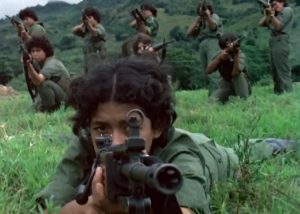This post includes material first published in Documentary magazine.
Documentaries of all kinds—including the expectable presold and slotted music docs, liquor-brand docs, sports docs—proliferated at SXSW 2018, the megamax film/music/techfest. Social-issue docs also laced the agenda, showing a wide diversity of styles, arguments and approaches.
Awards

Hao Wu’s People’s Republic of Desire Still
For once, festival awards agreed with my own personal picks. The top award in the doc feature competition went to Hao Wu’s People’s Republic of Desire, which I’ve been following for years. It was even better than I had hoped. Hao Wu (or Wu Hao, if you’re following Chinese custom) was a tech executive—he worked both in Silicon Valley and with Alibaba for years. And then he fell in love with documentary; his earlier work has showcased on public TV and this film was funded early on by ITVS. It’ll be on Independent Lens in the 2018-19 season.
The film takes us inside the huge—but largely unknown in the West—Chinese Internet phenomenon of live-streaming. This huge business features aspirational young people who attract followers on their Internet channels, both among the huge urban migrant population and among the nouveau riche. The poor develop fantasy relationships, and the rich throw money at the Internet stars by buying them virtual gifts. A dashboard perpetually measures the celebrity’s popularity. We meet a couple of celebrities, each desperate every night to win more; we also meet big spenders and a diaosi (average-joe/loser) worker. As you might guess, there are big interests behind it all, taking the lion’s share of the profits. Wu unwraps the mystery of who’s behind the curtain with expert pacing.
Wu brings both a sharply social analytical eye to the phenomenon and a warm interest in and empathy with his characters. “This is real-life Black Mirror,” he said at the festival. “It’s about the hyper-evolution of the Internet and of late capitalism at the same time. And we’re all players. This version is Chinese, but there are themes that echo in the West too.”

¡Las Sandinistas! Film Still
¡Las Sandinistas!, by Jenny Murray, won Special Jury Recognition, which made me very happy because I think the film rescues important social memory. History films are too easy to overlook, especially when they’re on international subjects. This is another ITVS film, although Murray only won ITVS support at the end of the process. Murray recalls the role of women in the 1970s Sandinista revolution. Focusing on several women who played leading roles, with interviews and rare archival material Murray demonstrates the centrality of their participation, and their erasure from official history in Nicaragua as patriarchal traditions reasserted themselves. She also shows how Nicaraguans experienced US intervention (recall the US funding of anti-Sandinista contra forces once the Sandinistas took power), and how that US role fed the demise of democratic processes and with it the public roles of the revolution’s women.
“Finding the archival footage was really hard,” Murray said at the fest. “A lot didn’t survive the two wars. Also, there were copyright holders we couldn’t find, for things that just electrified history. With fair use we were able to use bits of things that were game-changing for the film.” Another big challenge was trying to figure out how much explanation Americans need for a war and the role of American support for the contra counter-Sandinistas when it all happened, even then, out of the corner of a lot of people’s eyes. “The women’s stories should be in front,” she said. “I wanted the film to be in the women’s voices and not just have one narrator.” The women in the film are still angry. And still fighting for a better Nicaragua. I loved meeting them.
Finally, the Chicken & Egg Award went to Alexandria Bombach’s On Her Shoulders, which already won at Sundance. The film is both a remarkable portrait of Nadia Murad, a reluctant spokesperson for the Yazidi people threatened with genocide in Iraq, and also an oblique interrogation of journalistic coverage of human rights atrocities. “Everyone wants her to be Malala, and this to be a Malala film. But Nadia is a survivor, and she doesn’t want to be Malala,” Bombach said at the festival. “It was a new world for me,” she said. “I saw that repeating her story broke her down every time she told it, and that shaped how I interacted with her and what story she would tell. She doesn’t own her time, own her story, she’s at the whim of the advocacy beast that’s around her.” At times, she considered leaving the project, but knew that the company (Ryot) was committed to it, and would simply find another filmmaker. She strove to be the best storyteller she could. “I wanted to make a film that was non-sensationalistic, non ‘sex-slave.’ I wanted to protect her from the next director who called. We became closer and closer because I stayed around,” she said.
Handsome and calculated
Three films stuck out to me for their handsome design, high production values and clever, calculated framing. These are films with a clear, unambiguous agenda and a strategic use of storytelling to wiggle under the preconceptions of those viewers who are beyond the choir. Their methods bear watching.
Weed the People from Abby Epstein and Ricki Lake (The Business of Being Born), makes the argument for destigmatizing marijuana as a medicine. It focuses exclusively on pediatric cancer patients, their families and doctors. Marijuana is a promising anti-cancer medicine, as research in Israel and elsewhere shows. In a nation that uniquely demonizes a plant used for thousands of years medicinally, families face the challenge of unreliable and illegal supply, lack of research to guide dosage and lack of informed medical care. The film tugs at heartstrings, avoids the loonies and lets expert researchers give its arguments credibility; it also shows how easy it is to exploit parental anxiety without government-authorized research and regulation.
Epstein said that she and Lake, who earlier collaborated on a natural-birth documentary called The Business of Being Born (now on Amazon), were driven in this film and their earlier work by one question: “Why doesn’t everyone know this?” Lake’s late husband had discovered the cannabis pain relief CBD to deal with chronic pain; Epstein came to the topic with every negative stereotype of marijuana. Their investigations led them to desperate parents, charlatans and heroes. “Even though cannabis is good for a million conditions, we decided to focus on pediatric cancer,” Epstein said. “It’s a harder thing to focus on, but we knew it’d erase the stigma immediately. It takes out the idea that they’re enjoying getting high. These are the most emotional stories that will move the dial.”
Transmilitary, by journalist/filmmaker Gabe Silverman and advocate Fiona Dawson, features four transgender people who have sterling military careers—and who are variously charismatic, funny, kind and charming. “One of the reasons we honed in on active duty transgender service members is we didn’t want to fall into usual preconceptions of transgender individuals,” Dawson said. “We are hoping we can make an impact on people who don’t usually look at this topic. These brave men and women who you shake their hands when you’re walking through the airport, maybe you can reach other people who you might otherwise reach.” Indeed, their stories make as powerful a case for inclusion as you can make, plus you want to know what happens next to all of them. The film started out as a NYT Op-Doc, and the filmmakers hope both for broad distribution and a lively engagement campaign. “The transgender community has been fetishized in our media, and so has the military,” Silverman said. “I hope audiences can set aside their preconceptions and see themselves in the characters.”
Alison Klayman’s Take Your Pills (watch it on Netflix) looks at a national preoccupation with Adderall and other amphetamine-derived drugs. Showing a range of legal and illegal users, some of whom are happy to take it and others not, Klayman finds a common thread in a societal focus on individual achievement and success. “I’m always looking for stories that tell us something about the bigger systems and society we live in,” Klayman said at SXSW. “People often would say, are you pro or con? For me the question was why is this an iconic drug at this moment. This wasn’t in my list of film ideas, but this was an opportunity to have a really big impact, by asking the most urgent set of questions. Why is Adderall an iconic drug in America? The pressure that people feel to succeed, to get an edge, to be hyper competitive–it’s a perfect drug for late-stage capitalism. We’re little pieces of human capital.” For Klayman, whose film went worldwide on Netflix within a week of its premiere, SXSW was a golden moment to actually see it with an audience.
Personal and experiential.
There was highly topical work that was much less polished, too, like Adam Bhala Lough’s Alt-Right: Age of Rage, on antifa reponse to Charlottesville. The rough-around-the-edges work is carried by the genial Daryle Lamont Jenkins, a leading antifa activist, whose message is, “Hey, easy on the alarmism, we’re winning, because we’re right.” He calls for more antifa activists to meet the press, and explain why they want to fight for democracy and the future.

Chi-Town Film Still
And there were more evergreen items with a strong social agenda. Chi-Town, Nick Budabin’s moving multi-year saga of NBA aspirant Keifer Sykes, reminds one of Hoop Dreams, in its story of dreams deferred, denied, postponed and altered. Sykes himself, who grew up in the part of Chicago that has become notorious for its violence, is an extraordinary presence—an extraordinary athlete, a composed and committed husband, father, and son, and someone who seems to embody hope. Budabin, who supports himself as a showrunner (currently for VICE), while working on his indie projects, made the film over seven years. Showrunning helped, he thought. “I understand how to be entertaining while still having the emotion there. But they’re very different media. In reality TV you have a plan. You can’t make a cinéma vérité film and make appointments. You just have to be there.” His hope for the film? “I would love for kids to be inspired by Kiefer,that people who don’t normally watch social impact documentaries would watch this. And the other is audiences who only read headlines about Chicago. If we can get other people to have some empathy it would be a huge success.”
Two more personal, indie films both charmed me and kept my attention far longer than I had been expecting to give them. Gene Graham’s This One’s for the Ladies dives raffishly into the world of the mostly-male strippers of color who work hard and well to entertain the women taking a break from their own hard work in a racist world. It’s both exuberant and thought-provoking, and I felt privileged to have been invited in. It won a Special Jury Recognition Award (for best cast!). Jeremy Workman’s The World before Your Feet follows an odd-duck obsessive as he accomplishes his goal of walking every block of New York. I was afraid of a tedious personal indulgence, or a film that would exploit mental frailty. Instead the film quietly celebrated, and shared with viewers the experience of, looking closely, experiencing your moment and enjoying human interaction.
The Business
Streaming video services were everywhere at the festival. Filmmakers are looking for alternatives to the take-it-or-leave-it Netflix-style contract, and especially looking to hold on to some back-end rights.
If you had any doubt about the central importance of sophisticated visual design in films, a look at People’s Republic of Desire and Take Your Pills would disabuse you. Good documentary filmmaking is now also good animation, good graphic design, good data visualization.
Several panels focused on making a living in documentary. In one of them, successful documentarians shared ways to grow and survive in today’s hardscrabble and crowded marketplace. Alexandria Bombach said shooting weddings was a great way to train—because you’ll get the worst clients ever, you can’t miss the shot and you can’t forget any gear. Tom Hardy reminded folks to lean into community; it’s a generous one, but also no one forgets bad behavior. Doug Blush mentioned equipment rental and teaching. Bradley Beesley celebrated ITVS, as the largest funder of indie doc in the country and a coproduction ally.
In another panel, strategy to change today’s hardscrabble environment to a better-supported one was the theme. Jax Deluca from the National Endowment for the Arts highlighted takeaways from an ongoing, field-wide strategic planning process. The IDA’s Simon Kilmurry flagged the IDA’s funding database, as well as its collaboration with Reporters’ Committee on Freedom of the Press. Michael Bracy reminded filmmakers that their own mini-ecology depends on larger policy issues, such as net neutrality. Diane Becker heralded the nascent Documentary Producers Association. Wendy Levy is working with the Department of Labor to create paid apprenticeships in the arts.
Emerging
A lot of people are playing with virtual reality—there were too many documentary projects on display to see in one day. Many of them were passive-viewing 360 video, the low-hanging fruit of VR. My fave of that kind was a short VR for Good project (funded by Oculus, which matches nonprofits with filmmakers) from the UK by on testicular cancer awareness, Ryan Hartsell’s The Evolution of Testicles. It deftly used the form to surprise you, make you laugh, and hammer home the message with humor. You get to go up high in an air balloon shaped like a giant pair of testicles. Very, um, ballsy.

The Evolution of Testicles Film Still
Some created experiences within a gaming environment, allowing a viewer to move between interactives, VR and 360-video stories. The most intriguing to me was Lester Francois’ RONE, about an Australian street artist who paints highly crafted female portraits one- and two-stories high on decaying, about-to-be-demolished buildings. Viewers could browse in a virtual art gallery, watch a film, and visit various installations where virtual-reality tours of Melbourne street art and at-will explorations of Rone’s installations were available. The form was beautifully suited to the project, since Rone makes evanescent, site-based art, and the elegant design-made navigation, choice and experience a pleasure. Motherboard used the same format (and also the Unity platform) for a “museum-like” experience of endangered Brazilian jaguars.
But the limitations are still stark. The equipment is clumsy, access is minimal (perhaps 300 people at a festival), and smart-phone/Cardboard viewing surrenders on quality. Makers of course are endlessly hopeful than technological wizardry is around the corner.
Fandom
Some of SXSW is just about being a fan. I was thrilled to hear Barry Jenkins talk about the importance of film school, and of making your “calling card” films really, really short. I couldn’t believe I was sitting a few feet from Ta-Nehisi Coates talking about why he’s liking the challenge of writing the next Marvel comic narrative of Captain America. Watching the live podcast of “The Nod” (podcasting was huge at SXSW), I was surrounded by people who could anticipate every punchline and loved them all. And I found out who Tatiana Maslany likes best of the clones she plays on Orphan Black.
And Just Weird
I think the oddest moment I had in the festival was while watching More Human than Human, by Tommy Pallotta and Femke Wolting. It’s about the way AI (artificial intelligence) is all around us and getting big enough to be downright creepy. (Or worse than that; at SXSW Elon Musk went out of his way to warn people to be very afraid.) In it, an engineer is demonstrating the speech capacities of the robot he programmed, “Sophie.” To do so, he hits on her…and she winks. Really. I’m waiting for the robots’ #metoo moment.
